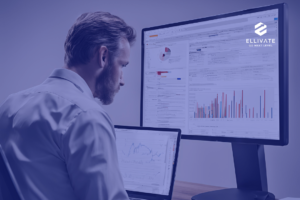Forget annual reviews and outdated metrics! The world of HR and performance management is undergoing a revolution driven by the power of data. Data-driven feedback systems are transforming how businesses empower their employees and achieve success.
This exciting new approach leverages a wealth of information, including employee feedback, key performance indicators (KPIs), and 360-degree assessments. Using sophisticated analytics, these systems identify key trends and areas for improvement, presenting insights on easy-to-understand dashboards. This empowers HR professionals and managers to gain a comprehensive view of individual and team performance, fostering a data-driven approach to growth and development.

Key Takeaways
- Data-driven systems give fact-based tips to workers.
- The correct feedback can bring trust and responsibility, helping workers take charge of their growth.
- But not everyone loves feedback. It can be hard to hear. Handling this isn’t easy and needs supportive leaders
- Letting workers have a say makes feedback even more powerful.
The Importance of Employee Feedback
In the business world, employee feedback is crucial. It helps improve employee performance and growth. As companies aim for constant learning, building a growth mindset is critical. This means encouraging your team to continually learn and improve from mistakes and not shy away from challenges. Doing so helps unleash their full potential and drives your company to long-term success.
Fostering a Growth Mindset
A growth mindset sees challenges as chances to grow, not barriers. Giving your team data-driven feedback can show them where to improve. This motivates them to own their development and look for ways to learn more. Such a change in mindset transforms your company, making your team resilient, flexible, and keen on improving.
Driving Performance Improvement
Using data-driven feedback strategies is powerful for better performance. Offering employees clear, actionable feedback lets them see where to develop. They can then focus on enhancing their skills and knowledge. This method boosts employee engagement. It makes employees feel responsible for their growth and helps the company succeed.
Building Trust and Accountability
Sharing employee feedback openly and regularly builds trust and accountability in your workplace. It’s about making feedback a natural part of your culture. This approach can grow respect and team spirit and strengthen each person’s sense of responsibility. These actions lead to improved employee engagement, better team efforts, and a stronger sense of ownership across your team.

Overcoming Resistance to Feedback
Organisations face a significant challenge in overcoming feedback resistance. Employees might doubt or worry about feedback systems, fear punishment, or be concerned about their privacy. To combat this, organisations should deploy strong change strategies and communicate well.
Feedback’s possible impact on pay and promotions stops some people from being honest or open. They might not say what they think out of unfamiliarity. They also fear they might be easy to identify or that there will be adverse outcomes. So, organisations need to explain why feedback is given, who it helps, and how they keep it confidential.
Educating both sides on feedback, its aim, and its advantages can ease the resistance. Having leaders who support the initiative is a game-changer. They can show how feedback helps growth and fosters a culture of accountability, which wins over employees and helps them see its value.

Feedback resistance can be caused by many things, such as fear of failure or distrust. Building trust is crucial to solving this. Giving clear, relevant, and actionable feedback helps the team see its worth.
Adopting coaching methods that fit your team’s learning preferences can be very effective. Letting employees participate in feedback by sharing their views and setting goals together also works. Celebrating wins can make feedback seem like a team effort.
Overcoming feedback resistance requires a well-rounded strategy. It is vital to tackle the emotional and logical hurdles your team faces. With effective communication, change management, and a culture of growth, feedback can truly benefit your organisation.
Data-Driven Feedback Strategies
In today’s work world, great feedback strategies are essential. They help your team improve. With advanced analytics, you can give clear feedback, letting your staff see where they need to improve.
Leveraging Performance Analytics
Use performance analytics to find powerful insights. This information guides your feedback. It uses real data, not just opinions, making your feedback fair and helping your team grow.
Objective Metrics and Key Performance Indicators
Feedback should be linked to important data, such as how productive someone is or how happy customers are. By using these key performance indicators, your team knows what they are good at and where they need to do better. This makes feedback clear. It also helps your employees see how they can improve in their jobs.
The Role of Data in Self-Perception
Data is critical in shaping how your team sees themselves. It helps them match their self-view with what’s real. Your company uses data to show employees their true selves. This boosts their understanding of their strengths, development areas, and ways to improve. It connects how they see their work with what the facts say. Thanks to this, they can wisely pick actionable next steps.
Bridging the Gap Between Self-Evaluation and Reality
Data-driven leadership methods are vital. They help employees know where they excel and where they need work. Things like 360-degree assessments reveal gaps between personal and others’ opinions. This self-knowledge is like a spark for growth. Team members learn to spot and fix their development areas.
This process helps team members make confident career choices. With the right information, they work on their strengths, face their flaws, and grab appropriate growth opportunities. This leads to more joy at work, better results, and a deeper connection with the job.
Effective Communication for Data-Driven Feedback
Being good at sharing data-driven feedback is critical. You must also be able to have difficult conversations, handle sensitive issues, and give constructive feedback. Listening well and showing you understand are vital. They help build trust, keep conversations open, and let employees know they are important and matter.
Leading Difficult Conversations
Sometimes, giving feedback on the data means discussing challenging areas or areas where they could improve. Be specific about what needs work and praise what they’re doing well. This can make feedback sessions more helpful and inspiring for your team.
Active Listening and Empathy
Listening well and showing you care can strengthen your team. It helps you understand their problems and ideas, which they’ll love. Add in understanding—really seeing and hearing their feelings—and you’ll build a place of trust. This makes conversations about how to improve more helpful.
Getting great at feedback means creating a place where team members want to improve. Good leadership communication and focusing on listening and care help. It’s the way to handle tricky conversations and provide feedback in the right way. This helps your team grow, and your organisation succeed.
Employee feedback
Continuous feedback is vital for any workplace. It lets your team share comments regularly, opening up an ongoing conversation that gives team members useful, timely tips. The aim is to boost their career growth and involvement in it.
Continuous Feedback Loops
Studies show that constant feedback boosts motivation significantly. With regular conversations and feedback, employees feel more valued and become more invested in their improvement. This can lead to happier teams and better company results.
The Power of Employee Voice
Integrating employee feedback isn’t just a courtesy; it’s a strategic advantage. Their on-the-ground experiences provide invaluable insights that can shape development plans and company strategies. This collaborative approach fosters trust and ensures feedback is tailored to address the needs of everyone involved. By empowering employees to contribute, you not only tap into a valuable resource but also boost morale and engagement, ultimately leading to improved results.
Data-Driven Performance Management
Today, organisations are rapidly changing. This is where data-driven performance management makes a big difference. It lets you set clear goals, keep track, and adjust your plans based on the data. By using facts to set goals and always watching how things are going, you ensure everyone on your team knows what to aim for.
Setting Measurable Goals
Good data-driven performance management starts with clear, trackable goals. You look at feedback, evaluations, and key metrics to determine these goals. This method ensures your goals are realistic but also pushes your team to do their best. It helps everyone see how their hard work ties into the bigger picture.
Tracking Progress and Adjusting Strategies
Monitoring progress and making changes is critical in data-driven performance management. With easy-to-use tools and intelligent data analysis, you can see how well your team and individuals are doing. You find out what’s going well and what needs more work. Then, you can change your approach quickly to keep moving in the right direction. Using data this way helps your team to improve constantly and succeed.
Building a Culture of Growth and Accountability
Creating a culture of growth and accountability is critical for data-driven feedback’s success. Firms prioritising this see significant performance boosts and how much their employees get involved.
Leadership Buy-In and Modelling
Firstly, this culture needs to be led from the top. Company leaders need to support and model data-driven practices. This sets a good example, motivating everyone to join in.
Celebrating Successes and Learning from Failures
It’s important to cheer wins and see failures as chances to learn. This helps show the actual worth of using data for feedback. By celebrating those who take risks and improve, companies make a space where everyone can grow.
Also, learning from what goes wrong boosts team spirit and problem-solving. It helps create an environment where mistakes are okay, leading to better teamwork and increased innovation.
Conclusion
Data-driven feedback isn’t just a trend; it’s a transformative approach to employee development and performance management. By integrating employee voice with objective data, organisations can create a culture of continuous learning, growth, and accountability.
This shift empowers employees to take ownership of their development journey. Armed with clear, actionable feedback, they can identify strengths, target weaknesses, and celebrate achievements. Leaders who champion this approach foster a supportive environment where mistakes are seen as learning opportunities and open communication fuels innovation and resilience.
The road to implementing data-driven feedback may have its bumps, but the rewards are undeniable. By overcoming resistance and building a growth mindset, organisations can unlock the full potential of their workforce, leading to a future of peak performance and lasting success.




